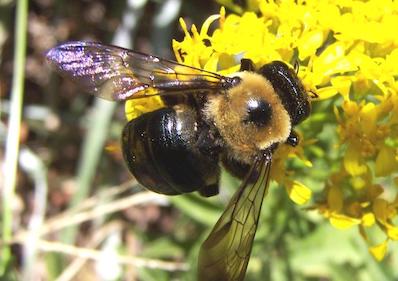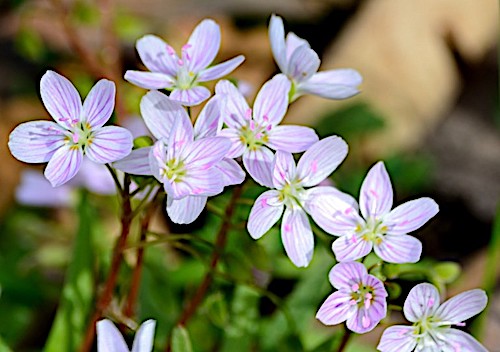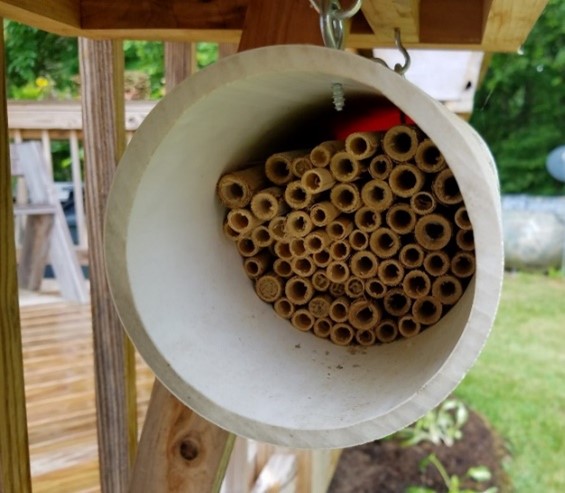Make a House for Native Bees
By Ann M. Mason, Fairfax Master Gardener
Spring brings flowers, new leaves and heralds the awakening of pollinators. Most of us think of bees, butterflies, birds, bats and bugs when we think of pollinators. Scientists estimate that native bees pollinate about 80 percent of the flowering plants worldwide. Native bees are among a gardener’s best pollinator friends.
Often when people hear the word ‘bees,’ they first think about larger bees such as honeybees. However, honeybees are not native to the U.S. and live in perennial colonies, usually in managed nests (hives).

Carpenter bee
According to university scientists, about 400 species of native bees live in Virginia. Most of the native bees are solitary and have a life cycle with one generation per year. People can observe larger native bees like bumblebees, Bombus spp., and carpenter bees, Xylocopa virginica, in the garden. However, many people overlook the multitudes of other native bees because they are small and are rarely seen.
Native bumble bees and some sweat bees live in small social colonies that are created annually in cavities or underground. In contrast, solitary native bees build nests in small cavities. Native solitary bees are not aggressive. They are too busy collecting pollen for their eggs and nectar for their own energy to pose a threat to humans.
How to attract native bees to our gardens
A garden needs four essential items. First, there needs to be a diversity of flowers that provide nectar for energy when the native bees awake from their winter slumber and pollen to feed their larvae. In short, to make your garden their home, you need to select flower species, preferably native plants, to supply a continual sequence of blooming flowers throughout the growing season from early spring to late fall. Native bees need flowers especially in the early spring and in the late fall when nectar and pollen sources are fewer. In fact, some of our native bees depend upon a limited species of flowering plants.

Claytonia virginica
To attract native bees, gardeners will want to select plants to nourish both the specialist and generalist native bees. Naturalists suggest some spring blooming flowers, such as spring beauty, Claytonia virginica, trout lily, Erythronium americanum, common violets, Viola sororia, redbud trees, Cercis canadensis, golden Alexander, Zizia aurea and golden ragwort, Packera aurea. Fall blooming flowers are essential to provide the overwintering females with the energy they need to survive the winter. Plants like asters, Symphyotrichum sp., goldenrods, Solidago sp. and woodland sunflower, Helianthus divaricatus provide native bees the nutrition they need.
Second, they need a habitat for bee homes. Native bees like to nest in cavities in hollow stems, underground or in hollow reeds. Many ground nesting native bees like to nest in the soil under leaf litter (not hardwood mulch). Some native bees want long pre-existing cavities. Leaving old flower stubble and stalks of asters and coneflowers provides a hollow tube perfect for native bees. In addition, you can build a bee hotel to attract these native bees.
Third, native bees need access to water and mud. Fourth, native bees, like other beneficial insects, need a place free from chemicals that might threaten their ability to live, eat and reproduce.
Steps to make a bee hotel
- Use natural reeds or cardboard tubes or other smooth tubes. Bees will not use tubes that are not the right size, so use a mixture of sizes with diameters ranging from about 1/8 inch to 1/2 inch (3 -12 mm). Mason bees favor tubes 5/16 inch (8 mm) in diameter.
- Use tubes that are at least 6 to 8 inches (15 – 20 cm) long; otherwise the bees will ignore your hotel.
- One end of each tube needs to be closed at the back to prevent predator entry.
- Inset the outer edge of the tubes about 3 inches (7 cm) into a protective structure that will reduce rain and wind.
- Every year after the bees emerge, replace nesting tubes. Old tubes can harbor disease and parasites that injure the next generation of bees. When the mud or leaf plugs at the entrance are gone, you can tell the bees have left the tube.
Locate your bee hotel in early spring when temperatures are above 55 degrees. - Bees need warmth from chilly evenings. Choose a location with full morning sun — ideally facing southeast. Elevate the nest 4 to 5 feet (1 – 1.5 m) above the ground. Mount it so it does not move or shake in the wind. The bees are happier if there is partial shade in the afternoon.
- Make sure your location is within 100 to 200 yards (90- 180 m) of a pollen source, within 50 yards (45 m) of a mud source and within 10 (9 m) yards from a source of fresh leaves.
- Consider protecting the nest so that the bees can enter, but squirrels and birds cannot. For example, hardware cloth can be affixed over the front of the nest to allow bees to safely emerge.
- After the bees leave their nesting tubes, replace used tubes. Use harvested reeds or purchase cardboard or natural reed replacement tubes.
- If the bees laid eggs in the tubes in the fall, store the nest over the winter in an unconditioned outbuilding with atmospheric temperatures.

Native bee “house” filled with nesting tubes made from natural reeds
Bees You May See in Your Bee Hotel
Virginia has dozens of species of solitary bees, including distinct kinds of mason bees and leafcutter bees, which use small cavities to construct nests made of mud or leaves. Bees that nest in bee boxes emerge in spring and summer and live for only one season. During the spring and summer female bees look for nest sites, build a nest and lay their eggs. Female bees leave pollen and one egg in individual cells they construct in the tube. Each cell is sealed off from the other cells as the tube is filled. Finally, bees close off the tube: mason bees use mud; leafcutter bees use leaf material. The egg within each cell becomes a larva, consumes pollen and spins a cocoon. The adult bee remains dormant within its cocoon until temperatures rise above 55°F (12° C) when they emerge.
Common native bees you might see include:

Resources
• Native and Solitary Bees in Virginia, Eric Day, et al, Virginia Cooperative Extension Publication
• Creating a Solitary Bee Hotel, Erin Bauer, et al., University of Nebraska at Lincoln
• Building and Managing Bee Hotels for Wild Bees, Julia Brokaw and Rufus Isaacs, Michigan State
University Extension Publication
• Help Native Pollinators with a Bug Hotel, Ashley Troth, North Carolina Cooperative Extension